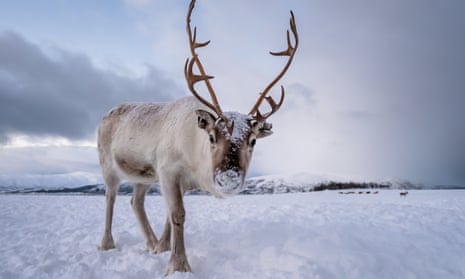If your ceaseless feasting at Christmas leaves you exhausted, it may be worth taking inspiration from reindeer: research suggests the animals can sleep while chewing.
During the summer months, reindeer spend most of their time munching foliage – an important activity given food can be scarce in the winter. However, a study suggests one way they balance their need to digest with the need to sleep is by multitasking.
“We speculate that in wild the rumination might take over an important part of the sleep coverage,” said Prof Gabriela Wagner, a co-author of the research from the Norwegian Institute of Bioeconomy Research in Tromsø, Norway.
Writing in the journal Current Biology, the team report that they collected data on brain activity from four adult female reindeer, using non-invasive electrodes stuck to their scalps – a method known as EEG.
The data was gathered over four days in each of the winter, summer and autumn seasons during which the animals were exposed to constant darkness, constant light, and a natural change between day and night respectively.
Analysis of the EEG data revealed that the reindeer spent, on average, the same amount of time asleep regardless of the season, with the proportion of time spent in each sleep phase – be it rapid eye movement (REM) sleep or non-REM sleep – also steady across winter, summer, and autumn.
Among other work the team carried out experiments in which they disrupted the reindeers’ sleep for two-hour periods, finding this led to an increase in slow-wave activity in the animals’ brains – indicating the animals felt the need to sleep.
“This indicates that the reindeer brain has an “idea” of how much sleep the reindeer need to function well – just like ours,” said Wagner. “This is not so in all animals.”
However, the team discovered that after the reindeer spent time chewing the cud, this slow-wave activity decreased – suggesting the sleepiness lifted.
“It was opposite to what we saw when we kept them awake,” said Dr Melanie Furrer, first author of the study from the University of Zurich.
Indeed, analysis of the EEG data, as well as behavioural observations, by the team revealed that during rumination the reindeer entered a state similar to non-REM sleep.
The researchers say on average the reindeer spent the same amount of time in this cud-chewing sleep state across the seasons – likely as a result of the captive environment of the study where easy-to-digest food was provided. However, Furrer noted that individual reindeer that ruminated more had less additional non-REM sleep.
The team suggest the findings could have important implications for reindeer in the wild.
“We think that the ability to sleep while digesting might be especially important during the short summer when the reindeer are very active all day to eat enough food [and] accumulate fat in anticipation for the food-sparse winter months,” said Wagner.
